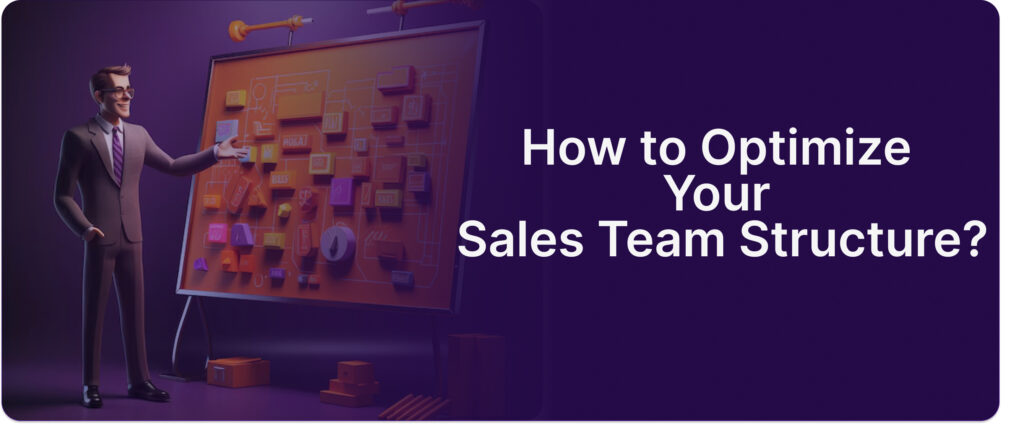
Businesses with an optimized sales team structure typically see faster deal closures, improved lead conversions, and better alignment between sales and customer success.
Have you ever wondered why some sales teams consistently outperform others, even when selling the same product or targeting similar markets?
The answer often lies in how their sales team structure is organized.
This article covers how to structure and optimize your sales team for success and scale a high-performance sales team.
How to Structure a Sales Team?
Whether you’re running a small business or managing a large enterprise, how you organize your sales team structure plays a vital role as it can either make or break your success.
It’s important to take into account the company’s size, goals, target market, and sales cycle when considering how to structure a sales team. Because that helps close deals more efficiently, enhances customer experience, and improves overall performance.
Here are the main roles you should consider when structuring your sales team:
1. Sales Development Representatives (SDRs)
- SDRs are responsible for prospecting and qualifying leads.
- They help build a sales pipeline by identifying potential customers and setting up appointments for executives.
2. Account Executives (AEs)
- AEs manage the sales process from demo to negotiation and closing.
- Account Executives take the qualified leads from SDRs and convert them into paying customers, they are closers.
3. Sales Managers
- Sales managers oversee the team, set targets, track performance, and ensure the team meets its goals.
- They provide coaching, guidance, and strategies to help their team succeed.
4. Customer Success Managers (CSMs)
- CSMs ensure that customers are satisfied, which can lead to renewals and upsell opportunities.
- In SaaS sales team structure, CSMs are crucial for maintaining long-term relationships with customers, and post-sale activities.
5. Sales Operations
- They focus on improving the sales process, tools, and metrics.
- Sales ops ensure that your team is working efficiently and has the data-driven insights they need to improve performance.
6. Sales Enablement
- They work closely with marketing to align messaging and content to the sales process.
- They provide the training, resources, and tools that the sales team needs to be effective.
How to Build a Better Sales Team Structure?
Once you’ve identified the roles that are needed in your team, the next step is to focus on how to build a better structure for the sales team.
Here are some key steps to consider:
1. Hire the Right Talent
- Look for individuals who not only have strong sales skills but also align with your company culture.
- Team members should have excellent communication skills, resilience, and the ability to learn and adapt quickly.
2. Onboarding and Training
- Make sure new hires are familiar with your sales process, product offerings, and market.
- Proper onboarding sets to team’s success.
3. Goals and KPIs
- Businesses can introduce commission structures for sales teams structures, to reward by offering a percentage of each sale they close. This will keep them motivated and work hard.
- Well-defined goals and performance metrics (KPIs) give your team a sense of purpose and a roadmap to success.
4. Collaboration for Better Sales Team Structure
- Foster a collaborative environment where your SDRs, AEs, and CSMs share insights and strategies.
- For example, SDRs can share feedback with AEs on which prospecting tactics are working, while CSMs can provide insights on how to best serve long-term customers.
5. Create a Positive Culture
- Encourage open communication, celebrate wins, and make sure that team members have the support they need to thrive.
- Creating a positive and supportive team culture is essential as sales is high pressure job.
SaaS Sales Team Structure
In a SaaS sales team structure, the focus is often on building long-term relationships rather than just closing one-time deals.
Here’s how to structure your SaaS sales team for success:
1. Customer-Centric Approach
- A SaaS sales team needs to be customer-centric, focusing on delivering value over time.
- SaaS teams often include CSMs who manage the ongoing relationship with the customer.
2. Emphasis on Renewals and Upsells
- Prioritize renewals and upsell opportunities and buy additional products or services.
- CSMs work closely with customers to ensure they are satisfied, which increases the likelihood of renewing subscriptions.
3. Focus on Product Knowledge
- In SaaS, the product is constantly evolving and sales teams need to have in-depth product knowledge to communicate to prospects and customers.
- This often involves close collaboration between the sales, product, and customer success teams.
How to Optimize Sales Process?
To optimize your sales process, you need to ensure that every stage of your sales funnel is running smoothly, especially in the B2B sales team structure. Here are some ways to improve:
1. Simplify the Sales Funnel
- Automation tools can handle administrative work, freeing up your sales team to focus on closing deals.
- Streamline the steps involved, eliminate unnecessary tasks, and make the process as smooth as possible.
2. Improve Lead Scoring
- Optimize your lead-scoring system so that your SDRs and AEs focus on the highest-quality leads.
- Use data to track which leads are most likely to convert and adjust your process accordingly.
3. Refine Your Messaging
- This is especially important in B2B sales team structures, where the decision-making process is often longer and more complex.
- Work with marketing to develop messaging that speaks directly to your customer’s pain points.
4. Implement Post-Sale Follow-Ups
- Implement a strong post-sale follow-up process to ensure customer satisfaction and open the door for upsell opportunities.
- Customer success managers can play a big role here by staying in touch with clients and addressing their needs.
5. Regularly Review Performance Metrics
- Key performance indicators (KPIs) like conversion rate, average deal size, and customer acquisition cost are vital for optimizing your sales process.
- Continuously track your sales metrics to identify areas of improvement.
Wrapping Up
A common problem many B2B sales teams face when structuring is the lack of real-time visibility into sales interactions and missed opportunities during crucial customer conversations.
This is where ConvoZen.AI steps in. Its AI-driven monitoring and automation, allow businesses to gain detailed insights into every sales conversation, ensuring that quality standards are met and that no sales opportunities slip through the cracks.
This innovative platform provides a clear pathway to addressing common issues in sales team structure, allowing businesses to drive better results with ease.
Get started today & book a demo!
FAQs
A sales team structure template is a pre-designed framework that helps businesses organize their sales roles and responsibilities efficiently.
Sales team structure models include the hunter-farmer model, where hunters focus on new business and farmers on account management, and the geographic model, where teams are divided based on location.
Best practices for sales organization structure include aligning the team with your business goals, and ensuring roles are clearly defined.


